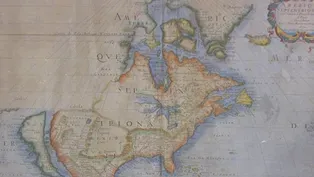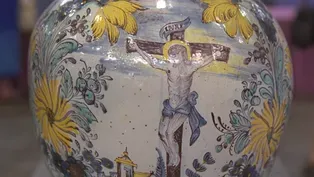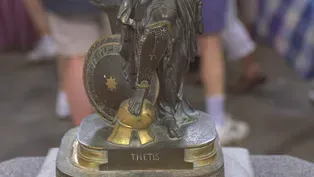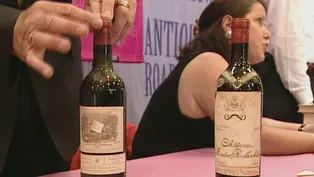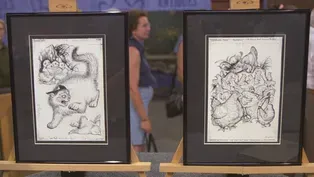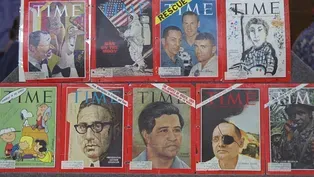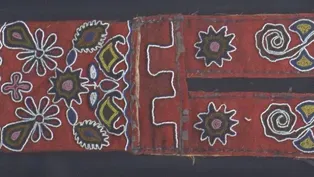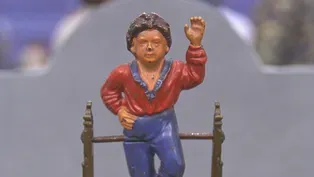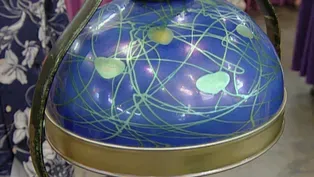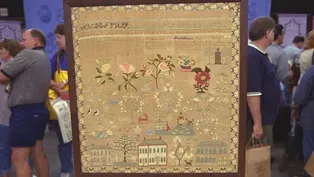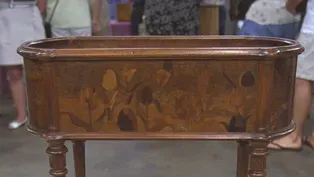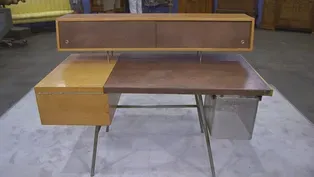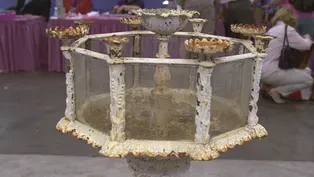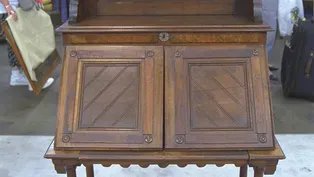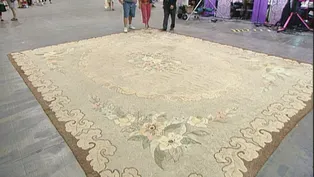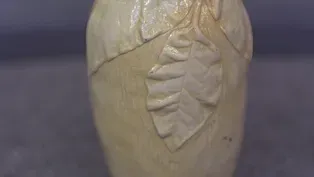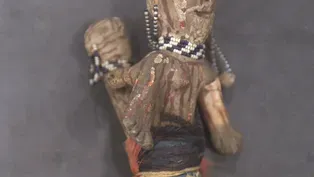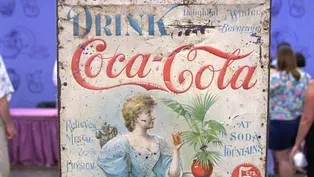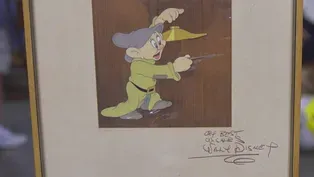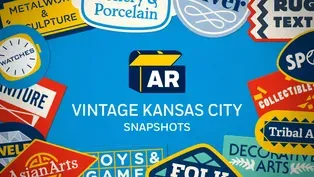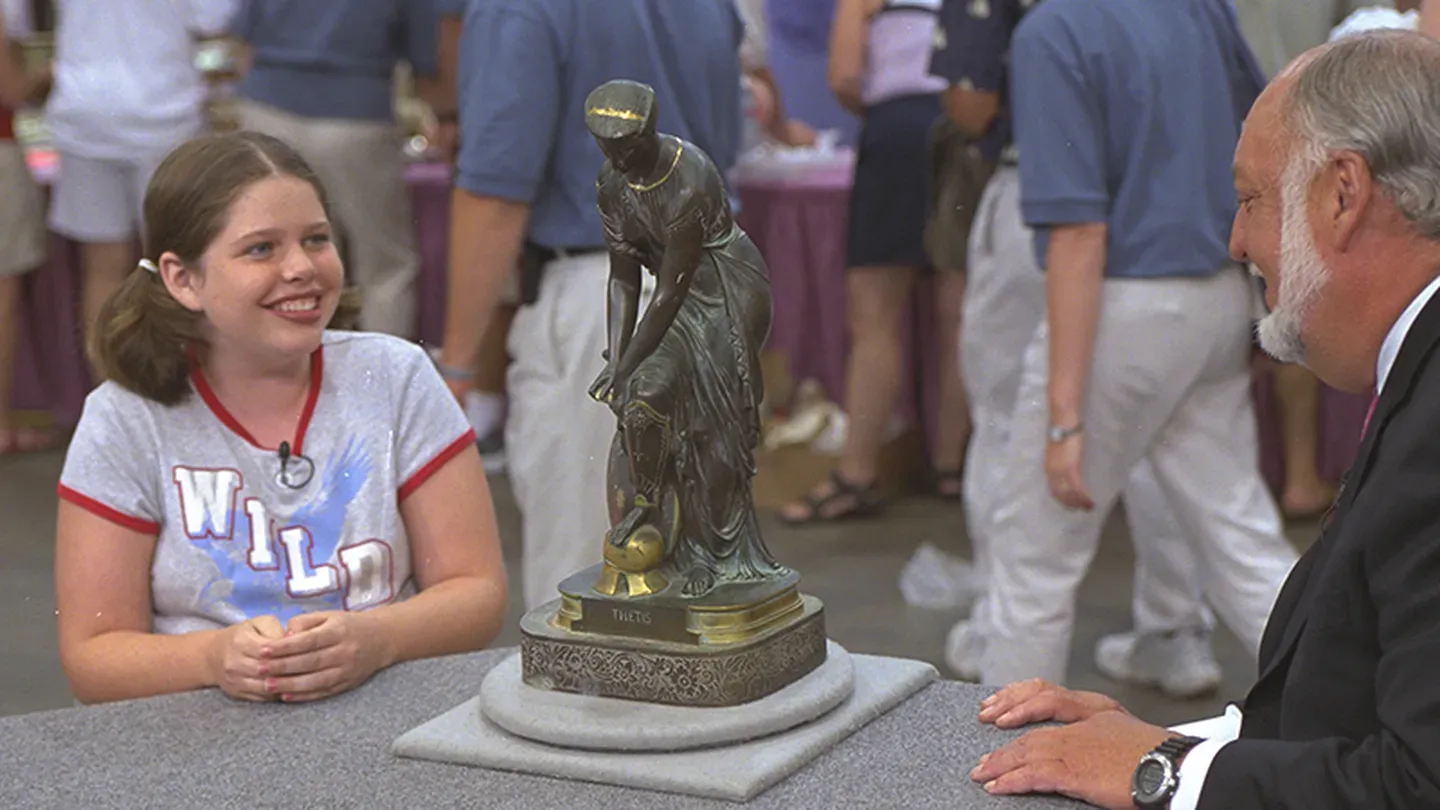

Vintage Kansas City
Season 21 Episode 24 | 52m 24sVideo has Closed Captions
Travel back 15 years to see treasures including an appraisal that jumps to $70,000!
Travel back 15 years to see memorable Kansas City treasures such as an autographed "Time" cover collection, an 18th-century flambé Meiping vase, and a 1957 Roy Rogers contest prize. Which appraisal jumps in value to $70,000?
Problems with Closed Captions? Closed Captioning Feedback
Problems with Closed Captions? Closed Captioning Feedback
Funding for ANTIQUES ROADSHOW is provided by Ancestry and American Cruise Lines. Additional funding is provided by public television viewers.

Vintage Kansas City
Season 21 Episode 24 | 52m 24sVideo has Closed Captions
Travel back 15 years to see memorable Kansas City treasures such as an autographed "Time" cover collection, an 18th-century flambé Meiping vase, and a 1957 Roy Rogers contest prize. Which appraisal jumps in value to $70,000?
Problems with Closed Captions? Closed Captioning Feedback
How to Watch Antiques Roadshow
Antiques Roadshow is available to stream on pbs.org and the free PBS App, available on iPhone, Apple TV, Android TV, Android smartphones, Amazon Fire TV, Amazon Fire Tablet, Roku, Samsung Smart TV, and Vizio.

ANTIQUES ROADSHOW 2025 Tour!
Enter now for a chance to win free tickets to ANTIQUES ROADSHOW's 2025 Tour! Plus, see which cities we're headed to!Providing Support for PBS.org
Learn Moreabout PBS online sponsorshipYou can see, it's had a hard life.
It's been shot at and stabbed, but I'm very attracted to it.
Wow.
That's a doorstop.
That's a doorstop?
It's a doorstop.
Well, you better put it up on a pedestal now.
♪ ♪ MARK WALBERG: Longtime "Antiques Roadshow" viewers have watched antique and art markets fluctuate greatly over the years.
APPRAISER: The market's come down a fair amount.
This one, being so rare, may be among the few that would still be worth quite a bit of money.
APPRAISER: In today's modern living, there's not a lot of use for something like this, and so it affects its value.
In the economy today, what's one of the dominant growing economies?
China.
The Chinese want to collect their own things.
WALBERG: It's been 15 years since our visit to Kansas City, Missouri.
Do you think this Roy Rogers toy set is still prized in the collectibles market?
Let's find out in this fresh look at Kansas City.
You got this box in the mail in 1957.
'57, uh-huh.
And you were a little disappointed.
I was disappointed because it was third-place in a contest that I had entered, a Roy Rogers contest.
And the first prize was a pony.
Mm-hmm.
Second prize was a one-week trip to the Double R Bar Ranch.
That would have been fun.
And this was the third place.
And I wanted the pony, so I was disappointed, but my mom did a great job of keeping everything.
That's what's amazing, that all this has survived.
Mm-hmm.
Now, what was the contest again?
It was a Baker's Instant Chocolate contest on why I liked it in ten words or less, and I said, "It's easy to mix and the flavor is delicious."
And I was ten years old at the time, and I won.
You got a great prize.
I did.
If you'd gotten the pony, we wouldn't be here today.
Exactly.
Obviously, it's the Roy Rogers cap gun set in the original box, and of course, you know how much we like original boxes.
Right.
But what also makes this kind of fun is that we have this presentation letter Mm-hmm.
signed by Roy Rogers himself, the king of the cowboys.
Right.
And these are a special edition, apparently.
Gold-plated.
They're 14-karat-gold-plated, mm-hmm.
Well, if I was a Roy Rogers collector, this would have to be one of the king points of my whole collection.
So I think you did all right, considering a pony or a weekend at the ranch.
It's pretty hard to put a value on something like this.
Mm-hmm.
I don't know how thick the gold-plating is on this leather, but it's really quite a fun thing to see.
I've seen Roy Rogers gun sets in this box.
Mm-hmm.
A run-of-the-mill one is $500, $600.
Sometimes a really fancy one could be in the $1,500 range.
So, I mean, that's really pretty nice.
Uh-huh.
I'm just wondering if that pony would be still worth $4,000 to $5,000 today.
(gasps): Really?
That would be my thought.
Oh, wow!
I never would have dreamed, ever.
MAN: This actually belonged to my great-great-grandfather, who was a physician in Deming, New Mexico, and that, we believe, is where he acquired it.
When you analyze a map, the first thing you look at is the title.
"Amérique Septentrionale," and it's done by Nicolas Sanson, who was a well-known geographer.
It's got a date, 1650.
The big question is, was this really done in 1650?
Right.
The answer is, yes, it was.
Now, what makes a map valuable is when it shows something new for the first time in history.
And this is one of the great maps of America, because it does show something new in history.
And the information for this came from the Jesuits, who were the great missionaries and the great explorers.
One of the great things about this map is, this is the first printed map to show all five Great Lakes in North America in 1650.
It's the first map to name Lake Superior.
And of course, they still didn't know how far out to go, and these are left open-ended.
So this is a major map for this whole part of the country, New England, the St. Lawrence Seaway, the Great Lakes, and so on.
Now, another thing about this map is, even though it was published after Champlain came back to France, you've got this depiction.
Notice there's no single Mississippi River.
No.
There's a huge confluence of water coming out here.
So they knew that.
So they extrapolated and put a whole lot of rivers in here.
Your great-great-grandfather probably bought it because it shows such, so much information on the Southwest, Mm-hmm.
but the real importance is the new information here.
There's a fascinating geographical error where California is shown as an island.
This is one of the great maps.
We have one in my shop in Philadelphia right now, and we have a price of $6,500 on it.
Wow.
So... That's... fantastic.
That's quite a price, yes.
WOMAN: It was in my grandmother's family, and as a child, I can remember my aunts used to keep vases with magnolia leaves in it.
You knew the piece was made by Gallé.
Mm-hmm.
Émile Gallé was really one of the most important French Art Nouveau decorative artists, and he is very well-known for working in other mediums, and in fact, most of our viewers just know him as a glassmaker, and he was really considered one of the greatest glassmakers.
But we've never really been able to show a great piece of Gallé furniture.
This piece was made about the time when he was first working in glass, in the 1880s.
And one of the reasons why I know that it probably dates from that period is that this signature is very similar to the signature that you'll see on some of his early glass pieces, which were done with enamel work on the glass.
I've seen a fair amount of his Art Nouveau furniture, and there are many sets of nests of tables and two-tiered tables and cabinets, but you don't see this planter.
In fact, this is the only planter I've seen.
What I love about this is, it's got this beautiful marquetry inlay work.
What we have is a very fine Art Nouveau design of tulips, and we have on the sides these beautiful leaves that would spring from the tulips themselves.
And on the back, you have more tulips, but it's not even the same design, so it's really an art piece.
It's really carefully thought-out.
Now, not only do you have this lovely inlay design, but you have some carving on the legs.
There's a repeating leaf pattern that echoes the leaves that you find on the tulips themselves.
If we had this in the gallery, I would probably put a price on it somewhere between $10,000 and $15,000.
Grandma and Grandpa had good taste.
"Girl With Menu," it's called.
Sells for about $150.
♪ ♪ MAN: This is Grandpa's entertainment center.
And down in here... Would be the lazy Susan for his whiskey.
Your piece, from an artistic point of view, is the Arts and Crafts version of an entertainment center.
APPRAISER: What you have is Venetian glass.
These are commonly sold by antique dealers one at a time.
We're lucky to even get one piece, let alone 12 of everything.
I'm so impressed, I can't tell you.
The total appraisal, I would say in the $4,000 to $5,000 range retail.
Congratulations!
Thank you, that's good news.
You're welcome.
Yeah, that's fun.
You know how long I've been waiting to do wine on "Antiques Roadshow?"
Really?
A long time.
I love wine, and you brought in a couple of fine bottles.
So the shape of the bottle, it's called a capsule shape, and that is typical of Bordeaux.
If you think of Burgundy wines, they have more of a tapering neck.
That's a different type of grape, Pinot noir.
But Bordeaux-- Cabernet and Merlot is the primary grape of Bordeaux.
So they're both from Bordeaux, they're both from the best estates in Bordeaux.
They're called first growths, which means, out of all the wines in Bordeaux, five are selected to be first growths, and you've got two of the five first-growth wines.
So much of wine is driven by year, as well, and '59 and '28 were both really good years.
The one word of caution is, I could tell you, on one hand, that the wine in the bottle could be good, but the way it's stored and what's in there now is always a mystery to us.
And one thing that I look for-- I look for several things, actually.
Number one, very often, there will be leakage through the capsule.
There's no leakage under these capsules, so that's a good sign.
Number two, though, is the fill level.
And if you look at the wine over here, you'll see.
This is called a shoulder fill level.
This is a higher shoulder fill level, okay?
The lower the fill level, it means, over the years, if they've not been recorked and changed, wine evaporates, air gets in.
And air is your friend once you open the bottle to drink it.
It's your enemy beforehand, it compromises the wine.
I would say this one has a pretty good chance of still being good, although it's getting there.
This one, being a 1928, I'm not sure if the wine in that... Have you, did you drink any of the three you brought over?
Time to crack one, you've got a perfectly good excuse for it.
'59 Lafite in mint condition is probably about a $1,000 to $1,500 bottle of wine.
And a '28 Mouton Rothschild, which is a fabulous wine, if it's in, if it's still in good condition, you're probably still looking at about $1,500 to $2,000 for that bottle of wine.
These are really super wines, so thank you very much.
It's great to see these.
When you open them up, can I come to the house?
Absolutely.
Don't mind inviting myself.
Lousy cook, but good wine.
WOMAN: When I was about ten years old, I wanted a hobby, and my mother had heard about people collecting the autographs on the cover of "Time" magazine, and suggested that I try doing it.
I started by writing a short hand-written letter addressed to whoever was on the cover of the Time magazine, and then my mom would help me.
She'd usually read the article, get a good idea of where that person was, and we'd always give return postage and an envelope, and amazing, we got several of them back.
What you have here is about, what, 170 or so?
Yeah, well, I think about 163.
163 "Time" magazine covers, signed, all from 1964 to about 1970.
Right.
What I really love about your collection is the variety-- it's incredible.
I mean, here we have Marc Chagall the artist and Apollo XIII, the three astronauts.
Here we have Neil Armstrong, right after the moon landing, and then entertainers-- Rowan and Martin.
It's a tapestry of history, a very significant time in history, the mid to late '60s.
I've always kept this as a collection.
I've never taken anything out and framed it or had it appraised separately, and I just was wondering if it's really important to keep this together as a collection and make sure it's passed down to another generation, or does there come a time when each one should be on its own merit and just is worth only what that person's autograph is worth?
I would keep it as a collection.
Now, as far as value goes, certain ones are going to be worth more than others.
Right.
I mean, the Apollo XIII, the Neil Armstrong, these have true value.
Yeah.
But as part of a giant collection, it really raises the value of everything.
And that's what we like to see.
If I were to insure the collection, and I would, because it's very important.
It's ephemera, it's paper.
Yes.
You got to take care of it.
I would insure it for no less than $12,000.
Really?
Wow.
Yeah.
WOMAN: We bought the desk in about 1951, '52.
We ordered it from Grand Rapids, Herman Miller factory, and I understand it was designed by Charles Eames.
APPRAISER: How much you paid for it?
WOMAN: About $500, which was an enormous amount.
We were very much in love with the Charles Eames designs, had a couple of his chairs.
The whole idea of it being very modern and very cutting-edge and up-to-date at that time was very appealing.
Now, you're right to say that this is a desk that was marketed by the Herman Miller Company out of Zeeland, Michigan.
Oh, okay.
However, the designer of the desk is not Charles Eames, it is George Nelson.
Oh.
Now, Nelson was the director of the Miller Company for years, from the '40s on, and he is really one of the finest American designers of the 20th century.
There's a nice investigation of materials.
We have a blond mahogany wood.
There's a great leather surface on the top and then also these doors, and then metalwork in the legs, and also this kind of fun Pendaflex file.
You've sat at this desk-- how comfortable is it?
It's a great desk to work at, really, because everything is at your fingertips.
Show me some of those things that you might... Well, this opens up, and it was back in the times before computers, and we had at one time a portable typewriter that you could attach on here, and then it would be down in the well.
Right.
And it has a lot of little storage areas in here, places for paper and stuff like that.
Yes, as well as these storage areas along the top.
So George Nelson cared about you sitting at your desk, wanted to make sure that you had everything at your fingertips.
The desk is in very original condition.
It looks very good to me.
Oh, great.
Original leather top.
It's got a little surface wear on it, but it's just the way these things should look.
You want to see some age imparted to them.
When we're seeing these things at auction, estimated really, I would say, in the $6,000 to $8,000 range.
Oh, really?
Wonderful!
Yeah.
That's great.
Ten years previous, you could have found it, you know, on a street corner in Manhattan.
Yeah.
No one would have cared.
(laughs) Well, I'm glad we held onto it.
That's terrific, thank you very much.
The lady that made it was my great-great-grandaunt.
Okay, and the great thing about it is, too, it tells where she was living at the time that she did it.
If you look right across the top here, it says right next to her name, "Newtown, Connecticut."
And the other thing that she talks about over here is when her father and mother were married in the 1820s, and this has her birthdate.
1822.
1822, yeah.
And then it's got a couple of other siblings there.
Two more sisters.
Right.
Unfortunately, her father died at the age of what, 38.
This is a schoolgirl's sampler.
Back in the 18th and even up through the mid 19th century, there were schools that taught young girls how to do this, and if you were a dutiful young lady in your family, you would go to school, and by doing this and proving that you could do this real complicated needlework, you were basically proving that you had the discipline to become a good wife.
(laughs) Which is kind of ironic.
Not exactly a new-millennium approach to womanhood, No.
but that's the way it was back then.
And the other thing that's really cool about this, that I love, is the fact it was the great strawberry border, has wonderful decorative elements-- houses, got Adam and Eve over here-- she was using silk thread on linen.
In my opinion, she left this area up here blank originally to do family history.
There's a word in the trade we use, called a keeper.
In other words, if you could get this, you would keep it, because it's such a good thing.
It's not glued down.
That was the one thing I was concerned about.
Lots of times, they glue these down to a board, and it's still floating.
And we had a discussion at the folk art table.
We felt like its value is around $30,000 or $40,000.
$30,000 or $40,000?
Yeah, yeah.
You're kidding!
Pretty good surprise for the day, huh?
I think I should have it insured.
You might want to do that.
GIRL: My grandma got it in Florida when she was visiting relatives.
She got it either at a flea market or at a garage sale.
That's where she gets almost everything.
She got it for $15, $20, probably.
Uh-huh.
And she got it because my sister Portia, my dad, and I all like Greek and Roman mythology.
That's pretty much the only reason she got it.
Have you tried to find out anything about the piece, or...?
We looked up Émile Hébert, which is, like, right here, Uh-huh.
and all we found was, he could be a writer, but we figured he probably wasn't.
Well, one of the problems that you had when you were looking him up was that his first name is Pierre.
So you had to know that this signature, which is here, Émile Hébert, is actually Pierre Émile.
But he is a well-listed artist.
And he's a, what we call kind of a Neoclassic artist.
What I like about the piece is that, first of all, it's bronze, and it has the gold doré inlays on it, which are very, very nice.
I don't particularly like the fact that someone didn't cover it when they were painting, because up in here, you can see the paint... That can probably just be washed off with water.
You know, you have to be a little careful.
Water's not going to hurt it.
Probably you should take it to a professional and have them try to clean it for you.
What is important to the piece is, on the back here, it is dated 1867.
Okay.
Also important is that it has the foundry mark, who actually cast it for the artist, GS, and it was a gold-medal winner.
So this actually won a prize at the Salon in Paris in 1867.
This artist was quite well-known for this, and you're going to find that this piece would sell at an auction from $4,000 to $6,000.
Oh, my gosh!
That's a doorstop.
That's a doorstop?
It's a doorstop.
Well, you better put it up on a pedestal now.
On the back of the doll's head, it does indeed say, "Bru Jeune," and it's a small size and one of the things that really makes her rare.
She's worth at least $12,000 to $15,000.
Oh, my gosh, my mom's going to take it back.
Oh, no, I'm sorry.
I made you wait all this time and then lose your doll.
It's a souvenir yearbook from the 1949 Independence Yankees.
Here we have the page in which Mickey actually inscribed it and signed his name, "Mick Mantle," one of the earliest Mantle signatures I've ever seen.
This is probably worth between $3,000 and $4,000.
Wow!
How about that?
That is wonderful.
That's not bad, right?
Yes, very nice.
WOMAN: At least nine people here said they didn't know what it was.
Okay, well, it's a lime squeezer, and it was used by bartenders to squeeze limes for drinks.
How much is it worth?
Great piece.
About $500.
Awesome!
Thank you.
Can you tell me where you bought it and what you paid for it?
My wife picked it off at a garage sale for $100.
Whoa, well, that's a good buy.
This is an exceptionally large American hook carpet, made in about 1920.
Rarely see them this big.
Got a little staining issue right here and a little bit of a hole in the corner, but overall, it's in pretty good shape.
Probably worth $5,000 to $7,000 in today's auction market.
Sweet mama!
My darling!
Really?
Yeah.
Oh, my God!
Well, thank you very much.
Boy, that's great.
MAN: A friend of mine got it from an older lady that he had done some work for and gave it to him down in the Lake of the Ozarks.
And I kind of fell in love with it when I saw it, and it took me about a year and a half to talk him into selling it to me.
Well, what you have here is a really outstanding fish tank by J.W.
Fiske of New York.
They were an ironworks company and they're considered one of the most important companies in America for this kind of work.
This is a really outstanding example of a fish tank.
You have this elaborate design of the cranes on the base, and of course you have this bowl, which is all original.
It's extraordinary to see.
And then these really interesting little plant stands, where they would put potted plants on.
And these would hold candles, and here you would have a little fountain that bubbled and aerated the water for the fish.
This is a particularly harmonious combination, with the cranes and the fish tank.
But it's very, very rare.
You see the base from time to time, but with a garden urn on it.
But to see a fish tank in this complete state is really wonderful.
How much did you pay for it?
Well, I sell stone, so I traded him some rock.
He's got a landscape business, and gave him $500 plus some rock.
Added, about $1,000.
Well, you'll be happy to know that it's worth a bit more than that.
Even in the condition that it's in-- you can see it's been painted over and it's cracking pretty badly, and plus, the paint hides quite a bit of the detail underneath, Right.
and if you take off the paint, you very well might find a signature on this.
In this condition, I would estimate it to bring around $8,000 to $12,000 at an auction.
But what I would suggest is, actually getting it professionally cleaned.
Getting it professionally stripped, and, you know, if you spent about $1,000, it probably would be worth maybe $16,000, $17,000, or maybe even $18,000.
Okay.
WOMAN: The illustration's by one of my favorite children's illustrators.
His name is Garth Williams.
He'd probably be most known for his illustrations that he did for the Golden Book Company, the Little Golden Books.
He did a lot of those.
He did the drawings for this in 1949, so it's a new work.
And what's this book?
The book is called "Flossie and Bossie."
Well, I thought there were a number of things about this that were quite interesting.
And speaking of the book itself, one of the more interesting things to me is, that book is by Eva Le Gallienne, who was a very famous actress in New York in the 20th century.
I didn't know that.
She's extremely well-known in theatrical circles, so I was kind of charmed by the fact that she apparently wrote a children's book, which is very little-known, or at least to me.
Working artists' drawings for reproduction I always think are quite interesting because an artist is able to show some corrections and make some changes.
You see here where he's used white-out and changed the drawing.
See the information here about where and how it's to be used.
"No text under the picture, left hand."
So we actually get the sense of the artist's working drawing, and then how the drawing was manipulated to be used in the actual book.
His work is quite famous for another reason that you didn't mention, was his collaboration with E.B.
White and his original illustrations for both "Stuart Little" and for "Charlotte's Web."
Yes.
And as an illustrator, he's very well-known amongst collectors for that.
What is it that you'd like to learn from us today, if we can tell you anything you don't know?
Well, more than anything, probably just how to care for it.
Care is an important thing to be aware of.
And the main thing with any work on paper is to shield it from direct sunlight or too much light of any kind.
Aside from that, as long as it's framed with archival materials and acid-free backing and so on, they're not really as fragile as people think.
It's in wonderful condition now, and there's no reason it shouldn't stay that way.
I was able to find only one auction record for a drawing by Garth Williams selling, and that was a drawing sold in New York at auction two years ago, and it sold for $18,000.
It was a drawing of a mouse and it was dated 1945, so I did a little thinking and I called up the person who sold the drawing, who happens to be a colleague and a friend of mine, and I said, "Was this by any chance a Stuart Little drawing?"
And he said, "Yeah."
And that explained the price.
On the other hand, we discussed this, and both came to the conclusion that because of the incredible charm and activeness and fun of the subject, this would have to be worth at least between $6,000 and $8,000.
Oh, my gosh.
And possibly more than that.
Wow!
APPRAISER: You've brought this really handsome guy in the portrait, looks like an ancestor-- who was this?
This is a fella named Kid Nichols.
Mm-hmm.
He grew up in Kansas City and was a pitcher for the Boston National League team in the 1890s.
He won 360 games through his career, and then came back to Kansas City and retired here.
My grandfather, who was a local antique collector, amassed kind of a large collection, including this material.
And when I was a child, you know, I enjoyed playing baseball, collecting baseball cards.
And so he gave it to me for Christmas when I was nine or ten.
Kid Nichols pitched in the 1890s, which is really known as the dead ball era.
I think a lot of people out there think that baseball began with Babe Ruth, and really, there are a whole host of great players before him-- people like Cap Anson, Kid Nichols, and others.
And a lot of people don't know that Kid Nichols owns the Major League record, seven times 30 or more wins.
That's amazing.
Yeah.
And he pitched for the Boston Beaneaters in the 1890s, which later became the Boston Braves.
Huh.
And the 1890s, for a lot of collectors, like the Holy Grail-- very, very difficult to find things from there.
This cabinet card, this is Kid Nichols I believe taken in 1897.
Uh-huh.
And that year, I believe, he won 31 games.
It was one of his best years.
Wow.
Here we have another cabinet card taken of all the Boston Beaneaters, and of course, Kid Nichols couldn't have done it alone.
He had guys to help him like Tommy McCarthy, Hugh Duffy, and Jimmy Collins, who are all huge Hall of Famers, and all led the league in home runs at one time or another.
Wow.
And you can see right here, there is Kid Nichols.
Kid Nichols, of course, getting his name because he only came to the big leagues when he was 20 years old.
Wow.
So two very rare cabinet cards.
This fabulous, fabulous piece of his, probably done at an earlier age, before he became a ballplayer, because obviously no mustache here.
(chuckles) And then we have these great scrapbooks.
And including right here a letter from Ty Cobb, because Kid Nichols was elected to the Hall of Fame in 1949 with Mordecai Brown, Three Finger Brown, and Ty Cobb's saying he was the winningest pitcher that he ever knew.
If we were going to put an auction value on it, we would put it at about $10,000 to $15,000.
If you were going to insure it, however, we would tell you to insure it for at least $20,000.
WOMAN: My parents bought an estate in Tulsa, Oklahoma.
And in a chest of drawers they found the doll.
APPRAISER: How many years ago?
It was about the mid-'70s.
What do you know about it?
We didn't know too much.
My mom liked it and decided to keep it instead of selling it.
She had a friend come and look at a lot of American Indian items that she has.
The only thing he mentioned was that the Indians used to make these to sell to the trains going west as souvenirs.
And that's what he thought perhaps this was.
Well, that part's right.
This is from the area between like Los Angeles and the Nevada border, the Mojave Desert.
Okay.
And this is made by the Mojave Indians.
And they were a desert tribe.
There were very few of them by the time this is made.
And they did make these little clay dolls to sell as the railroads went through.
It started heavily between 1890 and about 1900.
Continued a little while up into the early 20th century and then just stopped.
Very few of them survived because they're fragile.
They break.
That's one of the things about yours, it's got a crack in the arm.
And it's a maternity figure.
And as I turn it around, you can see that it's got the little baby on the back.
You can also see the arm where it's been cleaned to fix the crack.
And it's neat because it's got a lot of details.
A lot of these don't have the details like the earrings, and the earring has a bead on it.
It's also got all the clothing.
It's got the red painted stripes.
They've become pretty collectible.
They're extremely rare because there were so few Indians making them from the Mojave tribe.
And it's a limited group of collectors, but they're pretty serious collectors.
So you're probably talking $2,500 to $3,500.
Wow, wow.
That's great.
The reason it's hard to figure out who made it is because the mark on this particular piece is difficult to see.
It's actually right over there, and it says "Fulper" for Fulper pottery.
And these are worth about $400 to $500 apiece or so.
Oh my!
APPRAISER: It's an 18th century Windsor chair.
And it was painted in the second quarter of the 19th century.
And the tartan plaid comes out as an icon for Scottish people to rally around.
APPRAISER: It's by the Gorham Company, and they made a special line starting in the later part of the 19th century called Martelé.
The word martelé refers to this hand-hammering pattern.
At auction, I would think we would get between $4,000 and $5,000.
Wow, that would be really nice.
I could pay off my car.
You could.
I could.
(laughing) APPRAISER: I saw this lamp, and you know, a lot of times you see combination lamps like this.
And you think that it's a Tiffany lamp, but this is not a Tiffany lamp.
It's a Handel base.
Handel was a company that was based in Meriden, Connecticut.
And another company made glass shades specifically for this base, and that company was Frederick Carder Steuben, based in Corning, New York.
And this is a Frederick Carder shade, probably dating from about 1915.
It's a wonderful shade.
I've actually not seen one of these in this coloration.
I've actually seen it with a rose background, but not a blue background.
And then we have this... these great leaves and vines decoration in gold aurene, and this lovely rim down here.
The lamp, it has a few little issues.
We're missing a lot of finish on the... what we call patina on this kind of base, and we're missing that.
So that is going to have impact on the value.
The shade is very special.
And if this were all perfect, I would say this lamp was worth between $7,000 and $9,000.
However, I have to bring the price down a little bit and say that in this instance because of the damage on the base, I'm going to say maybe $6,000 to $8,000.
MAN: This is a piece that we've had on our bookshelf for about 30 years.
And it came from my mother's side of the family.
And that's about all that I know about it.
APPRAISER: All right, well, what you have is a "Boy on Trapeze" mechanical bank.
Which was advertised as French's automatic toy bank.
And the reason they called it a toy bank was because the action of the bank as you put a coin into the slot, the boy will revolve and deposit the coin and go around.
As the coin became heavier, and it was heavier weight, it counter balanced so he spun around a couple times.
Oh, okay.
So the concept was that the boy got to see more action for his money.
Okay.
The actual patent model, which was made out of bronze, worked.
The problem is that that one was calibrated so that would happen.
When they made them in cast iron, they took away the finesse of the spinning.
They still deposit coins, but they don't do as much action.
The bank is cast with beautiful filigree and Art Nouveau heads made out of cast iron.
And this one is the best condition I've ever seen.
Basically the bank was established by Barton Smith for production around 1891.
It was produced for about eight to ten years.
And as far as we know after that, they went out of business.
So it was a limited production bank.
It was very fragile.
If the child dropped the bank, it would break those shafts.
The arms?
So consequently, there's not that many that exist today.
Paint condition in mechanical banks is everything as far as value.
The last "Boy on Trapeze" bank sold for $8,500.
Oh, my God.
The difference is that this is a lot better.
This one on the open market today, fair market value would be $10,000 to $12,000.
Really?
Yeah.
Well, I brought in an album that's been in my family for some time.
There are a total of 200 cards in it.
My older brother purchased it some time ago as far as I know in an antique place.
How much did he pay for it, do you remember?
Papers say $50, which I think's amazing.
$50?
But this was how many years ago, do you think?
Probably in the late '50s or very early '60s.
This is called a carte de visite album.
And this carte de visite was a type of photograph that was invented first in France, and then about 1859, 1860 it was introduced here to the United States.
And then the Civil War begins, Right.
and there are hundreds of thousands of soldiers on both sides going off to war.
Right.
And here is this photograph that's introduced from France that is a unique kind of photograph because the photographer is using a camera that has four or eight lenses.
So they can stand in the studio and have four or eight, or sometimes maybe even 12 photographs taken at one time.
At once.
And they were made of personalities and generals.
And what you have here is a great collection put together during the Civil War of Civil War personalities.
I think I counted there are like 40 generals here, Yeah.
there are many actors and actresses.
Today these are very valuable.
And there are three that I pulled out of here that I wanted to show you that are really, I think, pretty special.
The first guy we have here is a guy named John Menard.
All right.
He was the first Black congressman elected after Reconstruction.
All right.
Very rare photograph of him.
Sojourner Truth, I'm sure you heard of her.
Right.
She was a great Abolitionist, born a slave, tremendous, tremendous photograph.
This photograph on the edge is probably my favorite of all the 300 photographs that are in the album.
I've never seen this photograph before.
It was taken by a photographer in Washington, D.C., named Alexander Gardner.
If you flip it over and look on the back you'll see his imprint.
This guy's a cane carver.
He's sitting there in the studio with all of the canes that he's making.
It's a great occupational photograph.
Just to give you an example of what I think that these three photographs are worth, this photograph is probably worth around $1,000.
This one's worth around $1,500.
This one I think could bring $2,000 at auction.
You add up everything else in the album, and I think you probably have somewhere between $8,000 and $10,000 worth of photographs.
Oh my.
Oh my.
Are you surprised?
(chuckling): Yes, I'm stunned.
Well, this is a sign that I found quite a few years ago in a very old ramshackle house that was vine-covered.
And for some reason, it appealed to me.
I just went in to see what might be sitting there.
And here is what was sitting there.
But you can see it's had a hard life.
It's been shot at and stabbed.
And I know nothing about it, but I'm very attracted to it.
Coca-Cola collectibles are probably some of the hottest collectibles that are available.
Back in 1886, when Coca-Cola was invented in Atlanta, Georgia, they would mix the syrup with water.
Somebody mixed soda water with it.
Now Coca-Cola, how it actually got its name is it had the cola from the African kola nut and the coca leaves.
So there was a minor amount of cocaine that actually was in there.
This sign is probably one of the earliest and rarest Coca-Cola signs that ever was produced.
Oh my.
This is a pressed tin and lithographic decorated sign.
A lot of the signs from the late 19th century are actually a cardboard sign.
This one isn't, which makes it very rare and unusual.
Even though it has a lot of damage to it, this is one of those collectibles that a Coca-Cola collector would probably give his eyeteeth for, because there are so few of them out there.
You just keep it wrapped up in your house.
Do you hang it in your house at all?
No, I keep it wrapped up and I keep it in a room that has a dehumidifier in it so it doesn't rust anymore.
This sign, even in this condition, I would not be afraid to give you an auction estimate of $5,000 to $7,000.
And at a good auction when you had two Coca-Cola collectors that wanted this bad, wouldn't surprise me if it even went higher.
This sign in pristine condition sold not long ago at an auction for $42,000.
Oh, my goodness.
APPRAISER: Lou didn't sign a lot of sheet music.
In fact, this is probably the first piece of sheet music I've ever seen signed by Lou Gehrig.
MAN: Is that right?
I think that you have a piece here worth about $3,000 to $4,000.
Whoa.
It's not bad, huh?
I appreciate it.
Yeah.
APPRAISER: It's by one of the great makers, it's made by Märklin.
Märklin is the gold standard in toys.
Not many have survived because they'd stay in the water and get rusty.
APPRAISER: It's Japanese Satsuma made in the late 19th century.
It's very good.
I would say it's worth between $3,000 and $5,000 in today's market.
Oh, that much!
That much, that much.
That's good!
Thanks for bringing it in.
Thanks.
APPRAISER: This is so exciting to see.
You have a real icon of modern space age design.
This is a Weltron 2001 AM/FM, 8 track radio.
Designed in about 1970.
And what makes this really unusual is how pristine it is.
It was made in three different colors-- red, yellow, and white.
The white was the most common, but they're typically discolored and in very poor condition.
This one's in perfect condition.
You still have your handle that works perfectly, the antenna.
And you even have this little hook here so that it could hang from the ceiling if somebody wanted to.
You could expect to get about $200 for it.
Well, thank you very much.
I'm glad to know what the value is.
WOMAN: It was given to my great-great-grandfather, Major John Dougherty, who was an Indian agent for the Indians of the Upper Missouri, interpreter, hunter.
He came from Kentucky in 1810, 1817, somewhere along in there.
He did this up until 1840.
And then he came back to Clay County and lived there until he died in 1860.
This was given to him by one of three Indians-- White Plume of the Kansa tribe, Big Elk of the Otoe, and Iatan of the... oh, and I forgot.
That's quite all right, you're doing good.
And you've brought it in to hopefully find out which of those groups gave it to him, which tribe?
Yes, uh-huh.
Well, this is an extraordinarily rare thing.
And because it's so rare, there's not a lot of information about them.
Do you know what this is?
It was a tobacco pouch.
It was sewed together up at the top and fit over the pommel of the saddle.
It could have done that.
They were worn as a bandolier bag also.
Okay, okay.
And they're probably better known as shot pouches.
They carried shot... lead shot for the rifle.
These are... widely survive in the East, in the Great Lakes in the East.
And they're somewhat common.
All Native American art is rare, but on a comparative basis, they're somewhat common.
Bandolier bags from these groups are very rare.
Hmm.
I've seen a handful in my time.
Oh, really?
So I'm not going to really be able to specifically say-- I wish I could, but I can't-- say this is Otoe, this is Kansa.
It has some influences of both.
It also has some influences of the eastern Sioux.
And I know your great-great-grandfather traveled fairly widely-- up the Missouri, as far as Oregon.
Oh yeah, yeah.
I think this dates from about 1840.
Maybe 1830, 1840.
But even at that early period, this is all trade material.
There's no indigenous material here.
The edge here, you can see a little bit of fraying, it would have had what appears to be a blue-- turned somewhat purple-- silk edging all along the side.
These bifurcated tabs at the bottom are very unusual.
We don't see that very often on these bandolier bags.
In trying to obtain value, one of the things we do is look for sort of what I call the holy trinity: Uh-huh.
rarity-- this has it-- provenance-- this has tremendous provenance.
There's a fair amount written about your great-great-grandfather.
Yeah.
And lastly, beauty.
This, to me, is really beautiful.
Oh, well, that's neat.
Sort of my taste.
I don't know if it is for you.
Oh, yeah.
But for me, it's beautiful.
We could easily sell this in the neighborhood of $30,000 to $35,000.
Oh, my God.
WOMAN: My father was an airline pilot.
And during World War II he flew the C-54s out of Washington, D.C., over to Prestwick, Scotland.
And they took supplies over and brought the wounded back.
So when he was in Scotland, one day he took a trip up to Kilmarnock and found his way into a charming little China shop.
So he bought the Wedgwood Fairyland bowl, which he brought back to my mother.
This is the original bill of sale.
He paid two pounds, 15 shillings, which at that time was about five dollars.
This Wedgwood bowl is by a woman who worked for Wedgwood for a very short time-- I think eight or nine years-- and she did the Fairyland.
I think her name was Mabel Tabor.
Now, the lady said that the last two numbers on the code on the bottom of it are 68, which they said meant there were 68 of this particular bowl made.
Now, I don't know whether that's so or not.
It is, you're right, Fairyland Lustre.
The basic patterns on the interior and the exterior are called "Woodland Elves."
And it's from a series of a number of different designs done by a gal by the name of Daisy Makeig-Jones.
Really?
And so the artist's name that you have, unfortunately, is wrong.
Not the right, all right.
And she actually did all the designs, and she oversaw production of this Fairyland Lustre from about 1915 till about 1931.
Ah-ha.
And she actually ceased working in the factory about 1932.
Ah-ha.
Very, very popular.
On the inside of the bowl we have this wonderful design that is daytime.
And on the exterior of the bowl, we have nighttime.
Now, underneath the bowl we have the mark, which is the Portland Vase mark for the bone china, which it does show you that it is Wedgwood.
And it also has a pattern number.
The pattern number is for the design.
Uh-huh.
It's in wonderful condition.
Now, bowls of this nature at auction today are very competitive.
It would realize probably in the range of $2,500 to $3,500.
Really?
For insurance, I would appraise it more in the $4,000 range.
Okay.
Certainly a wonderful return on a two pound, 15 investment.
I would say so, yes, yes.
This was my grandfather's.
It was given to him during my father's birth in 1925.
I appropriated it from my father about 1968.
And it's been in my home ever since.
The material is porcelain, as opposed to pottery or clay.
And we can tell that... And I'll put my glasses on because I can't see.
When you flip it over, this sort of white color that you get here, that is the porcelain clay, the actual color.
Now, the mark that's there tells us when it was made and where it was made.
More importantly, for the moment, is the glaze itself.
This is a very specific type of glaze made in Asia, and it's called flambé, which is a French word.
And it just refers to this sort of mixture of beautiful turquoises, the sky blue, with this deep rich red sort of ox blood kind of a color.
And you'll also notice on the surface there's lots of little pits.
Mm-hmm.
That's characteristic of this particular type of glaze.
Now, this glaze is imitating a specific type of material first appearing in the 12th, 13th century in China during the Song Dynasty.
It was copied at a later date.
Now, the later date this was copied was during the 18th century, and that mark I showed you on the bottom actually indicates that this was made between 1736 and 1795.
Oh, my God.
It also says that it was made for the imperial household of China.
Oh, my God.
Those are all wonderful things.
The pitting, the color, the sort of green tinge around the top, the shape is called a meiping.
All those things verify that this is authentic, it's real.
It's a very special object.
It has one problem, and I'm going to spin it around, and you've mentioned it to me.
It's got a little bit of a line down through the glaze.
That's called a glaze crack.
And it probably came because somebody wacked the side of it with another hard object.
So would you like to know the sales value or sort of the insurance value, or does it matter?
The insurance value, because I have a feeling I'm probably going to have to do that.
You have a treasure from the Qing Dynasty, the Qianlong period.
I would insure this for $40,000.
Oh, my God.
If it didn't have that line I would insure it for $75,000.
Wow.
MAN: My great-aunt Daisy Beck was Walt Disney's grade school teacher.
And Daisy let him out of gym class so he could do more painting and drawing.
And he simply revered her.
And every time he was in Kansas City, he came by and visited, and several times at our home.
What we have is a classic cel, it's a gouache on celluloid, and it's Dopey from "Snow White and the Seven Dwarfs" from 1938.
And it's actually signed by Walt Disney.
Yes.
Which is interesting because Disney did not really sign a lot of things.
He was loath to sign even letters.
He had his secretary sign them.
He had... whenever he sent out cels he would have one of the artists do his signature.
And every once in a while for special people, he would sit down and make quite a production of signing either a letter or an actual cel.
Do you ever think of the name Daisy and the connection to Disney?
I don't know as there was any connection between Daisy and Disney.
Well, because I always think of... of Donald's friend Daisy.
You know, I think that might Yeah.
have been an homage to her, and the inspiration she created for him.
When it comes to value, this is a very clean cel.
Now, it's interesting because animation cels were only designed to last for the life of the production of the movie.
There was no idea of preserving these.
They were saved more by accident than anything else.
So that being a gouache on the celluloid, over a period of time they would crack.
Extremes of heat and cold would affect them.
This one is in extremely good condition, and it's a great shot of one of the Snow White characters.
A cel like this, by itself, would sell for $3,000 to $4,000.
There's a tremendous added value to having a real Walt Disney signature on a cel.
And it usually adds about another $3,000 to $4,000.
So you're looking at anywhere from $7,000 to $8,000 for this cel.
Well, that's great, yeah.
♪ ♪ WALBERG: I'm Mark Walberg.
Thanks for watching.
See you next time on Antiques Roadshow.
Appraisal: 1650 Sanson Map of North America
Video has Closed Captions
Clip: S21 Ep24 | 2m 13s | Appraisal: 1650 Sanson map of North America, from Vintage Kansas City. (2m 13s)
Appraisal: 1799 Italian Majolica Jug
Video has Closed Captions
Clip: S21 Ep24 | 1m 3s | Appraisal: 1799 Italian Majolica Jug, form Vintage Kansas City. (1m 3s)
Appraisal: 1867 Pierre-Eugène-Emile Hébert Bronze
Video has Closed Captions
Preview: S21 Ep24 | 2m 27s | Appraisal: 1867 Pierre-Eugène-Emile Hébert Bronze, from Vintage Kansas City. (2m 27s)
Appraisal: 1928 & 1959 Bordeaux Wine Bottles
Video has Closed Captions
Clip: S21 Ep24 | 2m 5s | Appraisal: 1928 & 1959 Bordeaux Wine Bottles, from Vintage Kansas City. (2m 5s)
Appraisal: 1949 Garth Williams Illustration
Video has Closed Captions
Clip: S21 Ep24 | 2m 43s | Appraisal: 1949 Garth Williams Illustrations, from Vintage Kansas City. (2m 43s)
Appraisal: 1957 Roy Rogers Contest Prize
Video has Closed Captions
Clip: S21 Ep24 | 2m 13s | Appraisal: 1957 Roy Rogers Contest Prize, from Vintage Kansas City. (2m 13s)
Appraisal: Autographed "Time" Cover Collection
Video has Closed Captions
Clip: S21 Ep24 | 2m 21s | Appraisal: Autographed "Time" Cover Collection, from Vintage Kansas City. (2m 21s)
Appraisal: Bandolier Bag, ca. 1840
Video has Closed Captions
Clip: S21 Ep24 | 2m 55s | Appraisal: Bandolier Bag, ca. 1840, from Vintage Kansas City. (2m 55s)
Appraisal: "Boy on Trapeze" Bank, ca. 1895
Video has Closed Captions
Clip: S21 Ep24 | 2m 22s | Appraisal: "Boy on Trapeze" bank, ca. 1895, from Vintage Kansas City. (2m 22s)
Appraisal: Carder Steuben Shade on Handel Base
Video has Closed Captions
Clip: S21 Ep24 | 1m 20s | Appraisal: Carder Steuben Shade on Handel Base, from Vintage Kansas City. (1m 20s)
Appraisal: Connecticut Sampler, ca. 1835
Video has Closed Captions
Clip: S21 Ep24 | 2m 22s | Appraisal: Connecticut Sampler, ca. 1835, from Vintage Kansas City. (2m 22s)
Appraisal: Emile Gallé Planter, ca. 1890
Video has Closed Captions
Clip: S21 Ep24 | 2m 8s | Appraisal: Emile Gallé Planter, ca. 1890, from Vintage Kansas City. (2m 8s)
Appraisal: George Nelson Desk, ca. 1952
Video has Closed Captions
Clip: S21 Ep24 | 2m 31s | Appraisal: George Nelson Desk, ca. 1952, from Vintage Kansas City. (2m 31s)
Appraisal: J.W. Fiske & Co. Aquarium, ca. 1890
Video has Closed Captions
Clip: S21 Ep24 | 2m 17s | Appraisal: J.W. Fiske & Co. Aquarium, ca. 1890, from Vintage Kansas City. (2m 17s)
Appraisal: Kearney & Wiggers "Modern Gothic" Desk
Video has Closed Captions
Clip: S21 Ep24 | 1m 3s | Appraisal: Kearney & Wiggers "Modern Gothic" Desk, from Vintage Kansas City. (1m 3s)
Appraisal: Large American Hook Carpet, ca. 1920
Video has Closed Captions
Clip: S21 Ep24 | 41s | Appraisal: Large American Hook Carpet, ca. 1920, from Vintage Kansas City. (41s)
Appraisal: Louis Comfort Tiffany Pottery Vase, ca. 1910
Video has Closed Captions
Clip: S21 Ep24 | 33s | Appraisal: Louis Comfort Tiffany Pottery Vase, ca. 1910, from Vintage Kansas City. (33s)
Appraisal: Mojave Souvenir Figurine, ca. 1895
Video has Closed Captions
Clip: S21 Ep24 | 2m 8s | Appraisal: Mojave Souvenir Figurine, ca. 1895, from Vintage Kansas City. (2m 8s)
Appraisal: Tin Coca-Cola Sign, ca. 1890
Video has Closed Captions
Clip: S21 Ep24 | 1m 56s | Appraisal: Tin Coca-Cola sign, ca. 1890, from Vintage Kansas City. (1m 56s)
Appraisal: Walt Disney-signed "Snow White" Cel, ca. 1938
Video has Closed Captions
Clip: S21 Ep24 | 2m 4s | Appraisal: Walt Disney-signed "Snow White" Cel, ca. 1938, from Vintage Kansas City. (2m 4s)
Providing Support for PBS.org
Learn Moreabout PBS online sponsorshipSupport for PBS provided by:
Funding for ANTIQUES ROADSHOW is provided by Ancestry and American Cruise Lines. Additional funding is provided by public television viewers.


